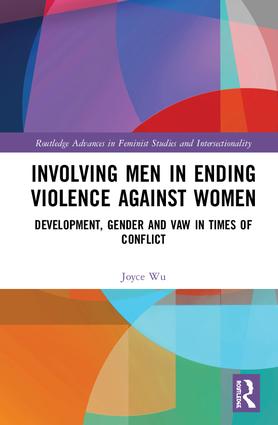Involving Men in Ending Violence Against Women: Development, Gender and VAW in Times of Conflict
by Joyce Wu, Routledge, 2018
Reviewed by Kate Bishop

Involving Men in Ending Violence Against Women is a welcome critical reflection on the reasons for involving men and boys in development programming to end violence against women (VAW), and to advance gender equality more broadly. Looking beyond the theory, Joyce Wu sets out to examine the realities of men’s roles in practice, the challenges and the imperfect outcomes, and ‘the assumptions in the aid context about appropriate roles for men in combatting violence against women’ (p. 5). In doing so she highlights the extent to which emphasis put on involving men and boys is depoliticising the women’s empowerment agenda in multiple ways. She also articulates how the trend hugely underestimates, and therefore undermines, the work of women’s organisations in the field of VAW who have been involving men for years in ways that are strategic, long term, and embedded in societies.
Whilst uncovering the reality of ‘involving men and boys’ in development programmes warrants attention in its own right, Joyce Wu adds a further layer by explicitly focusing on countries that are experiencing conflict and instability. She draws on three case studies from her own qualitative research in Afghanistan, Pakistan, and Timor Leste. However, her research – on which the book is based – demonstrates only too well the significant contextual challenges of research in fragile and volatile contexts, and she is candid about the constraints faced in all three settings. Therefore, while the programmatic case studies are useful cautionary tales regarding the potential pitfalls of involving men and boys as allies in the fight for gender equality, the limitations of the research do not allow the author to draw robust conclusions with national applicability, or to draw parallels between countries.
The particular pitfalls that the author encounters in the programmes she engages with will be familiar to those working to end VAW in many contexts. These include difficulties such as: working from acceptable religious, cultural or social starting points and failing to achieve transformative change in gender power but rather achieving a more benevolent form of patriarchy; a push to engage men and boys obscuring, and detracting funds from, the work to support women and girls; work with individual men, even with many individual men, that fails to address social norms or institutions that uphold gender inequality; and many men’s inability to play a supporting role in women’s empowerment, without taking centre stage, particularly in contexts of immense gender inequality.
The book could have gone further in drawing out analysis of the distinct nature of conflict and post-conflict settings. Joyce Wu rightly notes that conflict dynamics impact on VAW, but does not explore the mechanisms for this, whether through exacerbating drivers of VAW such as poverty, household stress, exposure to violence, through dramatic changes in gender norms or how households are constituted. Therefore, the book does not provide a clear starting point or analysis of why involving men and boys in efforts to end VAW might need different approaches in conflict and fragile settings, or might face different implementation challenges.
However, Joyce Wu is a thoughtful and self-reflexive writer, and considers gender and intersectional identity – how they play out in development programming, and how they affect the research on which the book is based. She also considers her own identity as a ‘Chinese-Australian woman in her early thirties’ (p. 37) and a ‘First World feminist’ (p. 36), and how aspects of her identity shape the interactions she has as the researcher, particularly with male interviewees. The discussion of research dynamics and challenges from an intersectional perspective will be of interest to researchers at all levels.
The book provides a thorough analysis of the theories of feminism and of gender and development, as well as specifically covering the history of VAW as it has been addressed in global development policy and practice. This gives the book its framing, and makes it accessible to a wide audience from development practitioners with or without gender expertise, to students at undergraduate and postgraduate level.
Cognisant that ‘involving men and boys’ is a donor-driven agenda, and therefore all but unavoidable for cash-strapped organisations working to end VAW, Joyce Wu advocates keeping analysis of power and a transformative agenda central to initiatives that involve men and boys. She rightly concludes by cautioning against unsustainable and un-transformative interventions, such as short-term ‘training’ or involving men without applying a ‘strong feminist critical lens’ that examines men’s rationales for engagement, including their desire to consolidate their own power.
© 2019 Kate Bishop
